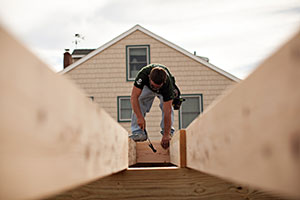Housing Starts Drop to Lowest Level in Three Months

New-home construction in the United States unexpectedly cooled in January, indicating there is a limit to how much gains in residential real estate will boost growth at the start of 2016.
Housing starts dropped 3.8% to a 1.1 million annualized rate, the weakest in three months, from a 1.14 million pace the prior month, a Commerce Department report showed Feb. 17. The median forecast of 76 economists surveyed by Bloomberg News was 1.17 million. Permits, a proxy for future construction, were little changed.
While all four regions of the nation saw a decline in construction, a crippling East Coast winter storm probably deepened the setback at the end of the month. A strengthening job market is projected to buoy housing demand this year, helping offset still-tight credit standards for some prospective buyers and turmoil in financial markets.
“We had a mild November and December, and there’s just a little bit of payback in January,” said Gus Faucher, an economist at PNC Financial Services Group Inc. in Pittsburgh, whose forecast tied for the closest in the Bloomberg survey. “I do expect to see growth in housing starts over the course of the year.”
Another report Feb. 17 showed wholesale prices unexpectedly rose 0.1% in January from the prior month as higher food costs more than offset the plunge in energy. Producer prices climbed 0.1% after falling 0.2% in December, according to figures from the Labor Department.
Economist estimates for housing starts in the Bloomberg survey ranged from 1.1 million to 1.23 million. The December figure was revised down from a previously reported 1.15 million pace.
Permits declined 0.2% to a 1.2 million annualized rate, indicating little scope for a rebound in construction this month.
The drop in starts last month was led by a 3.9% decrease in construction of single-family houses to a 731,000 rate.
Work on multifamily homes, such as condominiums and apartment buildings, fell 3.7% to an annual rate of 368,000. Data on these projects, which have led housing starts in recent years, tend to be volatile.
Regionally, the Midwest showed the biggest decrease last month at 12.8%. Starts also fell 3.7% in the Northeast, 2.9% in the South and 0.4% in the West, the report showed.
While January on the whole was warmer than usual across the country, a crippling winter storm in the Mid-Atlantic and Northeast probably curbed homebuilding later in the month. The weather event was rated as having the fourth-highest impact for a winter storm since 1950, accounting for accumulation and the concentration of residents in its path, according to the National Oceanic and Atmospheric Administration.
A report Feb. 16 showed homebuilders were less enthusiastic about the market outlook this month. The National Association of Home Builders/Wells Fargo sentiment index declined to 58, the lowest since May, from a revised reading of 61 in January.
The gauge of prospective buyer traffic also decreased to the weakest since May. Readings above 50 mean more respondents said conditions were good.
Unemployment at an eight-year low of 4.9% in January, coupled with faster wage growth, should help keep a floor under construction demand this year. Hourly earnings rose more than estimated last month after climbing in the year to December by the most since July 2009.
Favorable borrowing rates continue to cushion home buyers who are able to meet credit standards. The average rate on a 30-year, fixed mortgage was 3.65% in the week ended Feb. 11, the cheapest since April and close to the record-low 3.31% reached in 2012, according to Freddie Mac figures dating to 1971.

